-
Halloween
- The Story Behind Halloween – Lesson
- The Story Behind Halloween – Quiz
- Are You Too Old To Go Trick-Or-Treating? – Lesson
- Look out for the Blue Pumpkin – Lesson
- Is the White House Haunted? – Lesson
- Is the White House Haunted? – Quiz
- Mummies Discovered in Egypt – But That’s Nothing to Fear – Lesson
- Salem Witch Trials: When Being Called a Witch Meant Death – Lesson
- Halloween Around the World: It Isn’t Just Costumes and Candy – Lesson
- Halloween Around the World: It Isn’t Just Costumes and Candy – Quiz
-
Thanksgiving
- The Evolution of Thanksgiving – Lesson
- The Evolution of Thanksgiving – Quiz
- The Political Roots of Thanksgiving – Lesson
- The Political Roots of Thanksgiving – Quiz
- Turkey for Thanksgiving – But Why? – Lesson
- Turkey for Thanksgiving – But Why? – Quiz
- This Thanksgiving, Consider Helping the Less Fortunate – Lesson
-
Christmas
-
Easter
- Good Friday: Christ Carried Sin to the Grave – And Left It There – Lesson
- Good Friday: Christ Carried Sin to the Grave – And Left It There – Quiz
- Easter Traditions: From Rabbits to Egg Jarping – Lesson
- Easter Traditions: From Rabbits to Egg Jarping – Quiz
- Easter Monday and Egg Rolling at the White House – Lesson
- Easter Monday and Egg Rolling at the White House – Quiz
-
Federal Holidays and Observances
- New Year’s Day: Just as Political as Anything Else – Lesson
- This Presidents’ Day, Let’s Remember the Weird – Lesson
- Astounding Facts about US Presidents – Lesson
- Astounding Facts about US Presidents – Quiz
- Memorial Day: A Time of Honor and Respect – Lesson
- Memorial Day: A Time of Honor and Respect – Quiz
- From Decoration Day to Memorial Day – Lesson
- From Decoration Day to Memorial Day – Quiz
- Who Was the Poppy Lady, Moina Belle Michael? – Lesson
- Who Was the Poppy Lady, Moina Belle Michael? – Quiz
- The Origins of Flag Day – Lesson
- The Origins of Flag Day – Quiz
- America’s Flag – An Evolved Banner for an Ever-Changing Country – Lesson
- America’s Flag – An Evolved Banner for an Ever-Changing Country – Quiz
- Celebrating the 4th of July – Lesson
- Celebrating the 4th of July – Quiz
- Who Should We Thank for Labor Day? – Lesson
- Who Should We Thank for Labor Day? – Quiz
- Constitution and Citizenship Day – Lesson
- Constitution Day – The First Day of Constitution Week – Lesson
- Constitution Day – The First Day of Constitution Week – Quiz
- The Political Origins of Columbus Day – Lesson
- The Political Origins of Columbus Day – Quiz
- Columbus Day or Indigenous Peoples’ Day? – Lesson
- Columbus Day or Indigenous Peoples’ Day? – Quiz
- Veterans Day: A Day to Honor Those Who Served – Lesson
- Veterans Day: A Day to Honor Those Who Served – Quiz
- Marion Robert Goff: A Soldier’s Tale on D-Day – Lesson
- Marion Robert Goff: A Soldier’s Tale on D-Day – Quiz
- Independence Day: The History You Might Not Know – Lesson
- Independence Day: The History You Might Not Know – Quiz
-
Other Traditions
- Valentine’s Day Love Poems – Lesson
- Love Poems for Valentine’s Day – Lesson
- Who Was St. Valentine? – Lesson
- Who Was St. Valentine? – Quiz
- No Love for Valentine’s Day in the East – Lesson
- No Love for Valentine’s Day in the East – Quiz
- Beware the Ides of March – But Why? – Lesson
- Beware the Ides of March – But Why? – Quiz
- St. Patrick’s Day: A Celebration of the Irish – Lesson
- St. Patrick’s Day: A Celebration of the Irish – Quiz
- May Day: Dancing ‘Round the Maypole – Lesson
- May Day: Dancing ‘Round the Maypole – Quiz
- Cinco de Mayo: Celebrating Mexico’s Victory in Puebla – Lesson
- Cinco de Mayo: Celebrating Mexico’s Victory in Puebla – Quiz
- Mother’s Day: The Anti-War Effort Turned Holiday – Lesson
- Mother’s Day: The Anti-War Effort Turned Holiday – Quiz
- Father’s Day: More Than Just a Day for Ties – Lesson
- Father’s Day: More Than Just a Day for Ties – Quiz
- Presidential Fathers: Responsible for Their Kids and the Country – Lesson
- Presidential Fathers: Responsible for Their Kids and the Country – Quiz
- Proof of the Hanukkah Story Found? – Lesson
- Proof of the Hanukkah Story Found? – Quiz
- Roses Are Red, Violets Are Blue – April Celebrates Poetry, Too – Lesson
- Roses Are Red, Violets Are Blue – April Celebrates Poetry, Too – Quiz
Who Was the Poppy Lady, Moina Belle Michael? – Lesson
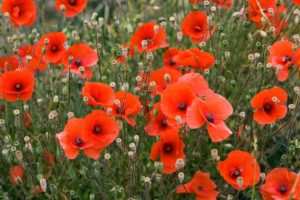
(Photo by Tim Graham/Getty Images)
Every Memorial Day, red poppies mark a tradition of honor that she began.
Who was the “Poppy Lady,” and why is she such an important figure today? Moina Belle Michael devoted much of her adult life to supporting wounded soldiers, and she is responsible for beginning the tradition of wearing red poppies on Memorial Day.
Moina’s Early Life
Moina’s family was wealthy enough that the young girl lived a comfortable life. At age 13, she started studying at the Martin Institute in Jefferson, Georgia. Two years later, she returned home to find her town and her family had fallen into poverty. At the young age of 15, Moina Michael began teaching to support the family.
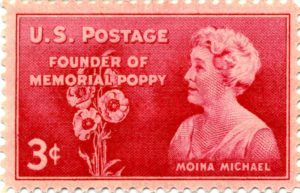
Moina Michael, promoter of Poppy Day observance, commemorated in US postage stamp of 1948. (Photo credit: US Post Office Department)
In 1914, she went on a tour of Europe and was in Germany when World War I broke out, forcing her to flee. In Italy she was able to get passage aboard a ship that would return her and other American tourists to the U.S. It took 16 dangerous days of crossing an ocean patrolled by enemy submarines.
After returning home, Moina became a professor at the University of Georgia, but she left the job when the US joined the war in 1917, taking time out to volunteer at the Young Women’s Christian Association (Y.W.C.A.) in New York.
The Poppy Lady
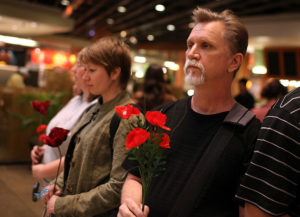
(Photo by Justin Sullivan/Getty Images)
In her autobiography published in 1941, called The Miracle Flower, The Story of the Flanders Fields Memorial Poppy, Ms. Michael described how she came up with the idea of wearing poppies to honor those who perished during the war.
On November 9, 1918, just two days before armistice would end the conflict, a young soldier entered the Y.W.C.A. and left a copy of the November Ladies Home Journal on her desk. In it, she discovered Colonel John McCrae’s poem, “We Shall Not Sleep,” which was later renamed “In Flanders Fields.” McCrae’s poem described the poppies he saw growing from the graves of fallen soldiers in Flanders, Belgium. Moina wrote a reply to the poem called “We Shall Keep the Faith,” with a decision “always to wear a red poppy of Flanders Fields as a sign of remembrance and emblem of ‘keeping the faith with all who died.’”
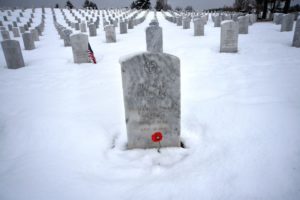
(Photo by Robert Alexander/Getty Images)
Three soldiers had donated some money to decorate her quarters and make them feel more like home. Instead, she took that money and bought 25 silk poppies. Others noticed how she had pinned the red flower to her lapel in memory of a fallen soldier, and the tradition was born. Moina later wrote in her autobiography about that day, saying:
“Since this was the first group ever to ask for poppies to wear in memory of our soldier dead, and since this group gave me the money with which to buy them, I have always considered that I, then and there, consummated the first sale of the Flanders Fields Memorial Poppy.”
Today, the little red poppies are sold to help collect funds for wounded soldiers, veterans, and their families. This is not just an American custom, either. In the United Kingdom, for example, people display a red poppy on Remembrance Day, which is similar to the U.S. holiday Veterans Day.
“We Shall Keep the Faith”
by Moina Michael, November 1918
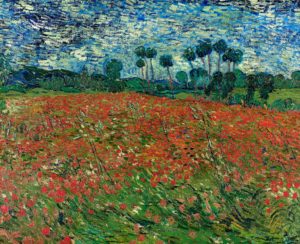
Poppy Field by Vincent van Gogh. (Photo by VCG Wilson/Corbis via Getty Images)
Oh! you who sleep in Flanders Fields,
Sleep sweet – to rise anew!
We caught the torch you threw
And holding high, we keep the Faith
With All who died.
We cherish, too, the poppy red
That grows on fields where valor led;
It seems to signal to the skies
That blood of heroes never dies,
But lends a lustre to the red
Of the flower that blooms above the dead
In Flanders Fields.
And now the Torch and Poppy Red
We wear in honor of our dead.
Fear not that ye have died for naught;
We’ll teach the lesson that ye wrought
In Flanders Fields.